
There was a golden age of subscription boxes, a time when the promise of a curated, surprise-filled package arriving at your door felt like a modern luxury. In this crowded market, “Try The World” shone brightly. It wasn’t just shipping products; it was delivering a culinary passport. Each signature teal box offered a journey to a new country—Spain, Japan, Morocco—through its most authentic and delicious artisan foods. It was a beloved concept for foodies and armchair travelers alike.
However, the landscape of direct-to-consumer brands is volatile. For those remembering that celebrated service, or for new customers wondering what the brand offers today, a crucial question arises: What is Try The World in 2025? This review examines the evolution of a once-great service and assesses what remains of its original promise.
The Golden Era: A Look Back at a Beloved Concept
To understand Try The World’s current state, one must appreciate what made it so special. The original subscription model was a masterclass in experience-building. For a recurring fee, subscribers received a box every month or two, themed around a specific country.
The curation was its soul. The team sourced high-quality, often hard-to-find products that genuinely represented the chosen nation’s gastronomy. A box from France might contain artisanal jam from Provence, buttery sablé cookies from Normandy, and a savory mustard from Dijon.
Crucially, this was paired with context. A beautifully designed “Culture Guide” accompanied each box, detailing the stories behind the products, the artisans who made them, and recipes for inspiration. It transformed a box of food into an educational and interactive experience. The unboxing was a moment of discovery, a tangible connection to a different part of the world. This formula earned it rave reviews and a loyal following.
The Pivot: What Try The World Has Become
Unfortunately, for fans of the original service, that era is over. Over the past couple of years, Try The World has undergone a significant transformation. The celebrated country-themed subscription model has ceased. Reports from former subscribers and online forums indicate a rocky transition period starting around 2023-2024, with many subscriptions halting abruptly, often with little communication.
Today, Try The World operates primarily as a standard online marketplace for gourmet foods. The subscription element, the very heart of the brand, has been removed. The website now functions as a storefront where customers can browse and purchase individual items or pre-made gift boxes.
While the shop still features a variety of international products, the core experience has fundamentally changed. The element of surprise, expert curation for a specific journey, and the educational component of the Culture Guide are no longer central to its identity. It has pivoted from a unique discovery service into a more conventional e-commerce store, placing it in direct competition with countless other online gourmet grocers.
The Current Experience: Shopping vs. Subscribing
Shopping on the Try The World website today is a straightforward, if less magical, experience. You can browse categories like “Pasta,” “Olive Oil,” or “Chocolate.” You can still find some interesting international brands, but the cohesive narrative is gone. The joy of being introduced to a new country’s entire pantry has been replaced by the familiar task of filling a digital shopping cart.
The curated “gift boxes” are the closest thing to the old model, but they are one-off purchases, often themed around occasions (e.g., “Movie Night”) rather than deep cultural dives. The sense of an ongoing culinary adventure has been lost.
Pros of the Current Model:
- Direct Choice: Customers can now pick exactly which products they want, eliminating the risk of receiving an item they won’t use.
- Access to Goods: The store still provides access to some international food items that may not be available in local supermarkets.
Cons of the Current Model:
- Loss of Core Identity: The brand’s unique selling proposition—the curated, country-themed discovery—is gone.
- Increased Competition: As an online store, it now competes in a very crowded market without its key differentiator.
- Damaged Reputation: The difficult transition away from subscriptions has left a trail of negative reviews and eroded customer trust.
- No More “Experience”: The service no longer offers the celebrated unboxing experience or the educational journey provided by the Culture Guides.
Conclusion: A Cautionary Tale for Foodies
Try The World stands as a poignant example of a brand that lost the magic that once made it a star. While its pivot to a standard online marketplace may have been a necessary business decision, it has undeniably alienated the very community of explorers and food lovers it so carefully cultivated. The service is no longer a “culinary passport.” It is simply a shop.
For returning customers hoping to recapture the joy of the old subscription, the current offering will likely be a disappointment. For new customers, it is one of many online options for buying gourmet food, but one that carries the baggage of a troubled transition.
In 2025, recommending Try The World comes with a strong caveat. While you may find a specific product you’re looking for on their website, the soul of the company—the joy of discovery, the expert storytelling, and the thrill of a journey in a box—is now just a memory. It’s a reminder that a great concept is only as good as its execution, and sadly, this culinary journey appears to have reached its final, and much less exciting, destination.



